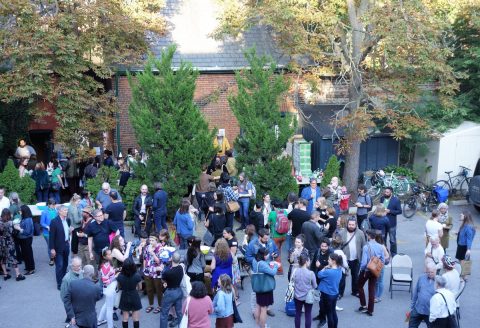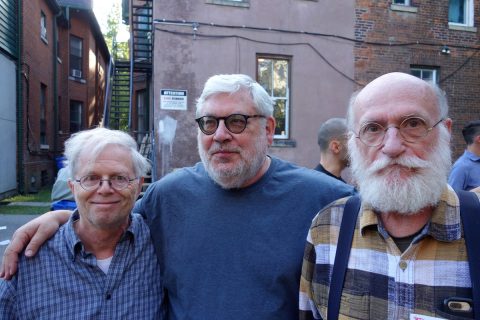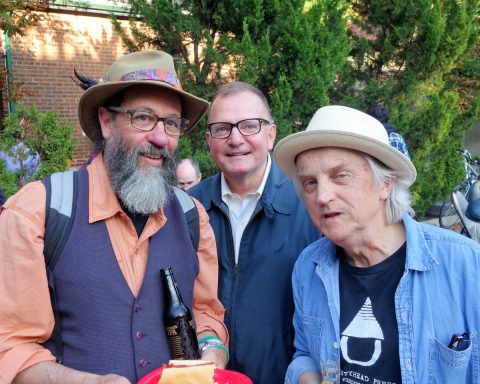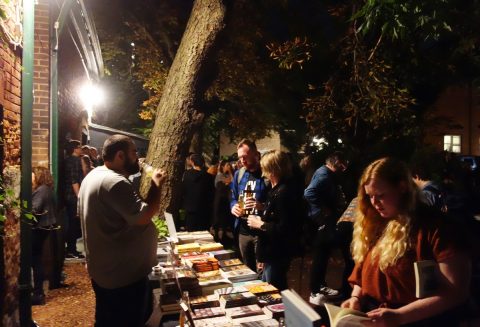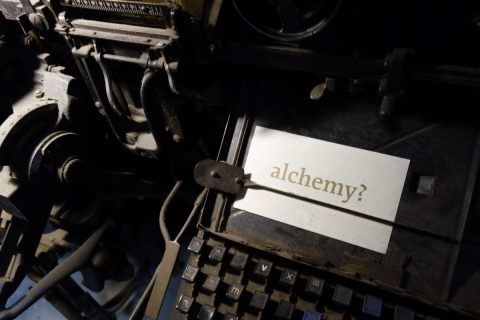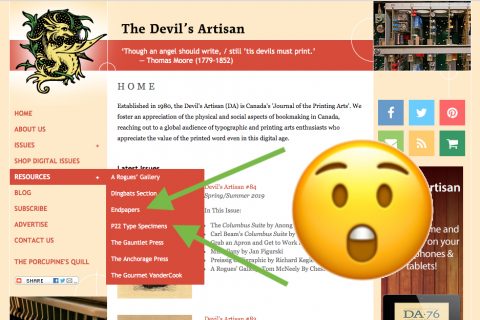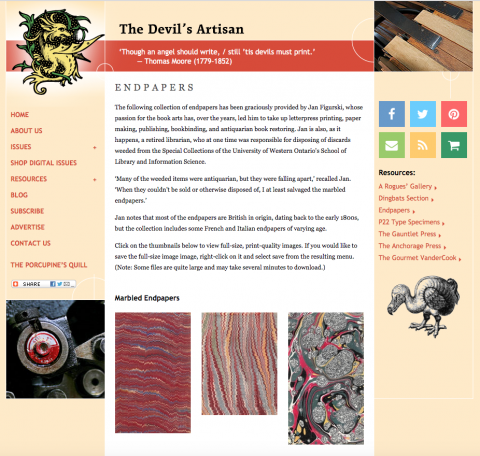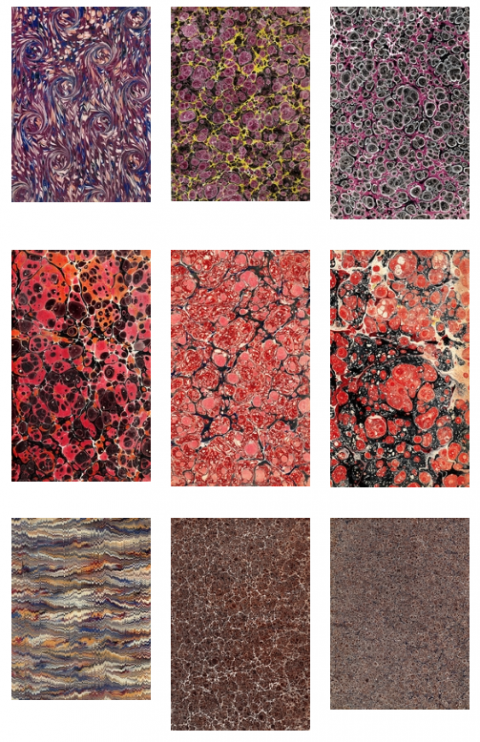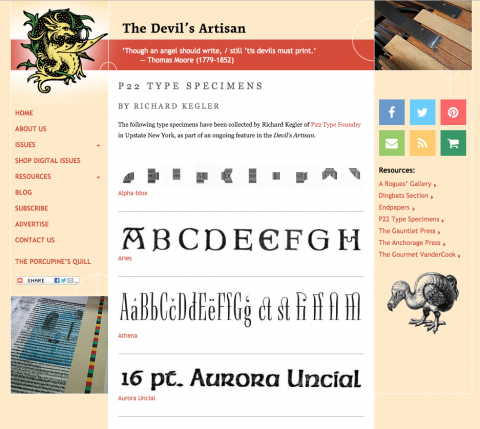The Porcupine’s Quill and the Devil’s Artisan will be participating in the upcoming Howard Iron Works Print Expo & Book Fair, on Saturday, September 28 at the Howard Iron Works Printing Museum in Oakville. This fantastic event is a must-see for anyone interested in the history of the printed word.
Our thanks to Liana Howard and Howard Iron Works for providing images in this post, as well as Peter Taylor, for images adopted from an earlier guest post.
* * *
The Porcupine’s Quill upgraded to a Polar Cutter in 1982. A 28-inch Model 72CE, with a split back gauge (very useful for trimming books) and hydraulics on the clamp as well as the blade. That is where this story begins. The Polar is a quality German machine, that we still run, most days, but there was one bit of functionality that we had with the old Pivano cutter that was lost in the upgrade.

Polar Cutter. Photo credit: Peter Taylor.
The Pivano cutter had power on the blade, but not on the clamp, which was a hand-powered screw mechanism. The clamp required quite a bit of upper body strength to set. The machine did provide an inexpensive alternative to weight training, but it also involved more effort than some employees wanted to expend on a regular basis.
The one bit of functionality we enjoyed with the Pivano, that we (somewhat unexpectedly) lost in the upgrade to the Polar was the torque that could be generated by the screw clamp on the Pivano that we were customarily mis-appropriating to crush the swell generated in the folds of signatures by the Smyth sewing machine. This was an ongoing issue because the Sulby binder required tight signatures or the spines of books might be crushed in the finishing stage.
The Pivano Cutter was somewhat clunky, but it was also a bit of a beast and the torque that could be generated by the hand clamp was fearsome, and effective.
The challenge of “puffy” signatures was an issue that wasn’t resolved until 1987 when we found an inexpensive used bundling press for sale at Howard Graphic Equipment on Dunwin Drive in Mississauga. Howard Graphic Equipment has since relocated to the furthest western reaches of Oakville, but I remember the old location because it was close to an upscale Italian restaurant called Rogues where Elke and I knew the proprietor, Tony Pereira, who had trained as a busboy at the Windsor Arms in Toronto and then later at the Millcroft Inn in Alton (near Erin Village). I feel confident that the Howards would have known Tony as well.
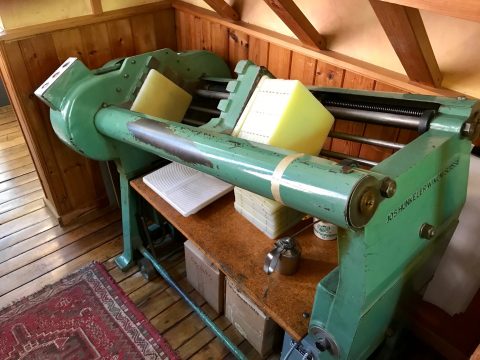
The Hunkeler. Photo credit: Peter Taylor.
The bundling press we bought from Nick Howard is Swiss, a Hunkeler MBP 90. Our capital equipment list suggests we paid the princely sum of $1300 for it, at a time when Howard Graphic Equipment was primarily involved in buying and selling large-format multi-color offset presses internationally. Heidelbergs, and Komoris. The sale of the Hunkeler to the Porcupine’s Quill may have been one of the least consequential transactions completed in the history of Howard Graphics, but I remember that, even as early as 1987, there was already evidence of the beginnings of the Iron Works Museum on display in the lobby of the cavernous warehouse on Dunwin Drive.
I suspect that Nick Howard may also remember the sale of the Hunkeler, possibly because it may WELL have been one of the least consequential transactions completed in his corporate history. Nick has been a godsend, on several occasions, and the fount from which salvation has been known to flow when we have found ourselves in desperate need of highly technical assistance of a rather esoteric sort. The Smyth sewing machine, once. And the Heidelberg KORD, once.
In July of 2016 I had been asked to participate in the 37th Annual TeX Users Group (TUG) conference organized by Pavneet Arora in Toronto. The conference attracted experts in the field of typography from Europe and Asia as well as a large contingent of Americans. One of the keynote speakers was Robert Bringhurst, whose seminal treatise The Elements of Typographic Style would have been well-known to the group. Part of the lead-up to the conference offered a tour into the countryside north of Toronto to visit the shop on Main Street in Erin. I remember one Austrian attendee, in particular, was enamoured with an edition of Lewis Carroll’s Alice’s Adventures in Wonderland illustrated with wood engravings by George A. Walker that we had published in 2011. The countryside tour WAS to have, also, included a stop at Howard Iron Works Museum but the museum was crated, that summer, in preparation for the move to its current location on Westgate Road in Oakville. The opportunity was lost, which was a regret.
The next summer I received an email from Nick Howard saying that he had recently bought a Linotype machine from a small-town newspaper somewhere in the American Midwest. The Linotype appeared to be in decent repair but it was not operational and wondered if I might know someone, possibly connected to the Devil’s Artisan, who might remember how to run a Linotype.
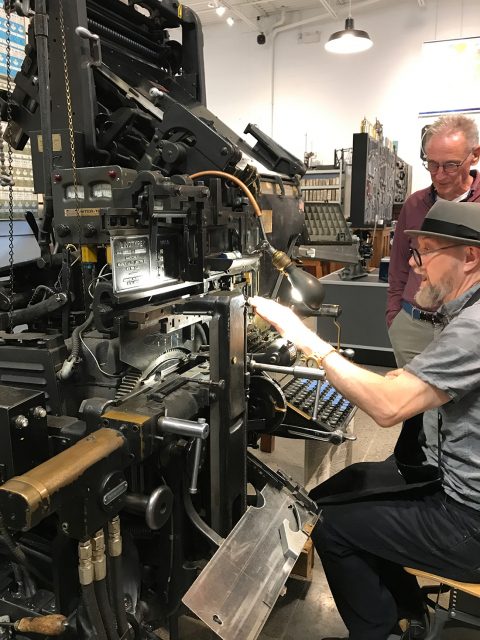
George Walker on the Linotype Model 31, 1953. Photo credit: Howard Iron Works Museum.
Naturally I remembered that George Walker had run an Intertype in the printmaking department at the Ontario College of Art. A very similar sort of linecaster. I contacted George, but George was more than a little reluctant to entertain the notion of carting off to the remote wilds of Oakville to service a Linotype of questionable provenance. It took some gentle persuasion, but George was eventually convinced to make the trek to Westgate Road. I had narrowly missed an opportunity to visit the Museum myself the previous summer with the TeX group, so I was curious to know what sort of a report I might get back from George about his expedition.
The way George tells the story I suspect the Howards (Nick, and his wife Liana) were more than a bit sceptical themselves, possibly because George did not look like the sort of iconic Linotype operator they had been expecting. A burly type, perhaps something akin to Don Black who had been a Linotype operator at the Globe and Mail back in the day. George Walker is not burly, and he is somewhat given to stylistic affectations that can often include a Charlie Chaplinesque pork-pie hat. Liana in particular was uncertain.
George was, however, able to recognize that there were a couple of critical bits and pieces of things missing from the Linotype in question, and asked if Nick Howard had “parts”. A fork-lift operator was dispatched and returned scant minutes later with a large wooden shipping crate labelled “Linotype parts”. George was impressed. Ever more so when the crate was opened to reveal an original parts manual for the machine, an operator’s manual and hundreds of parts in Ziploc bags, each labelled with the appropriate part number. George Walker is a wood engraver, an artist, a book designer, an art teacher and a half dozen other things but he is not a machinist and the level of professionalism on display at Howard Iron Works would have been utterly astonishing.
“The place is Wonderland,” said George. “You look around and realize that you are, already, down the rabbit hole.”
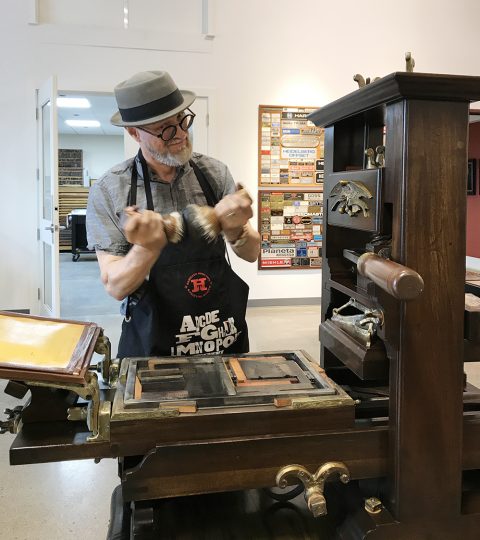
George Walker, looking ready to work at this a replica of a 17th century field press built in the late 1970s. Photo credit: Howard Iron Works Museum.
The Linotype Model 31, age 1953, is now fully operational and will be part of the demonstration George will give on Saturday, September 28 at the Second Annual Howard Iron Works Print Expo & Book Fair. George will also (time permitting) be demonstrating a wooden press the Howards have recently acquired … a replica of a seventeenth-century field press that would have been used in army field offices, and dragged around from location to another, by horse-drawn wagon.
* * *
Join us at the Second Annual
Howard Iron Works Print Expo & Book Fair
Saturday, September 28, 2019
10:00 a.m. – 4:00 p.m.
at
Howard Iron Works Printing Museum
800 Westgate Rd., Oakville, ON
(Half a dozen blocks west of the Bronte GO station.)
* * *
We hope to see you there!
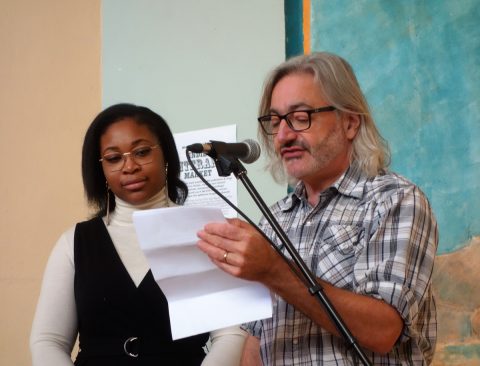
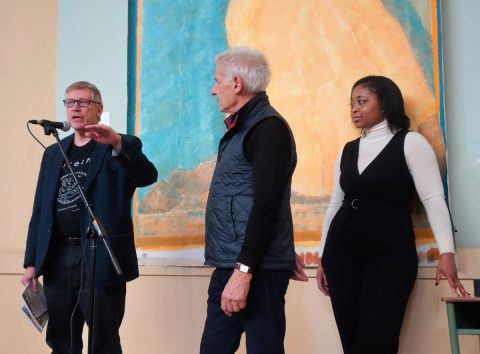
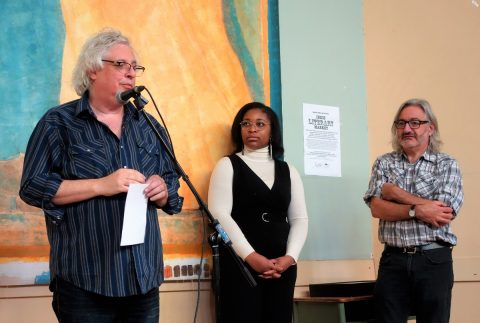
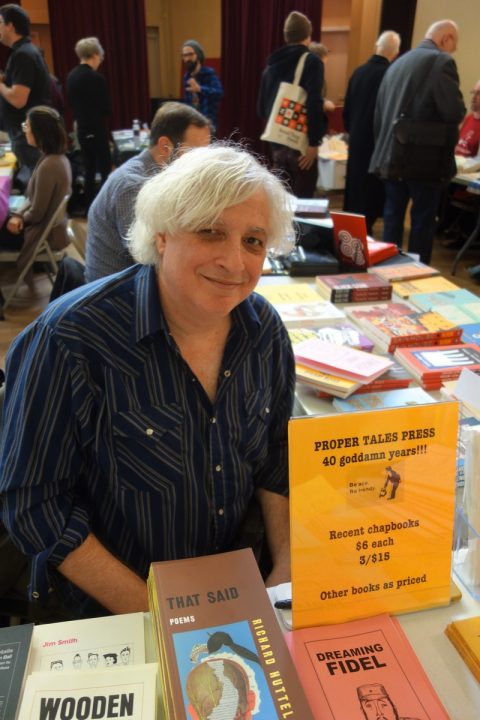
 Thanks to all who visited the Porcupine’s Quill / Devil’s Artisan table. And for those who couldn’t make it, we hope you enjoyed this little recap!
Thanks to all who visited the Porcupine’s Quill / Devil’s Artisan table. And for those who couldn’t make it, we hope you enjoyed this little recap!




